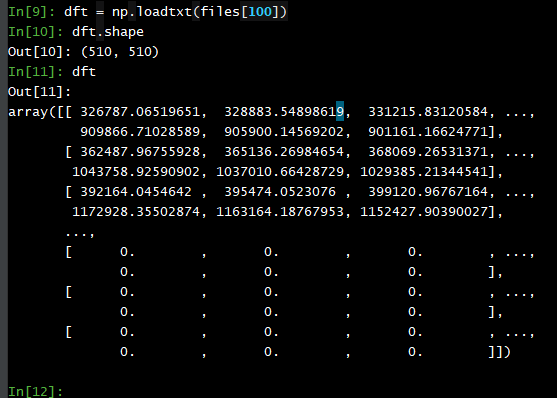我曾经使用mpi4py列出追加数据,并尝试将数据按顺序保存在source(root==0)节点。
按照 Alan22 的建议,我修改了代码并且它可以工作,但是脚本没有正确连接,所以我得到了如图 01 所示的输出文件。
任何人都可以帮助解决错误消息吗?此外,无论我用 python 脚本编写什么 [如下所示],都不是解决问题的最佳方法。 
有什么方法可以有效地解决这类问题吗?非常感谢任何帮助。
python脚本给出如下:
import numpy as np
from scipy import signal
from mpi4py import MPI
import random
import cmath, math
import matplotlib.pyplot as plt
import time
#File storing path
save_results_to = 'File storing path'
count_day = 1
count_hour = 1
arr_x = [0, 8.49, 0.0, -8.49, -12.0, -8.49, -0.0, 8.49, 12.0]
arr_y = [0, 8.49, 12.0, 8.49, 0.0, -8.49, -12.0, -8.49, -0.0]
M = len(arr_x)
N = len(arr_y)
np.random.seed(12345)
total_rows = 50000
raw_data=np.reshape(np.random.rand(total_rows*N),(total_rows,N))
# Function of CSD:: Using For Loop
fs = 500; # Sampling frequency
def csdMat(data):
dat, cols = data.shape # For 2D data
total_csd = []
for i in range(cols):
col_csd =[]
for j in range( cols):
freq, Pxy = signal.csd(data[:,i], data[:, j], fs=fs, window='hann', nperseg=100, noverlap=70, nfft=5000)
col_csd.append(Pxy)
total_csd.append(col_csd)
pxy = np.array(total_csd)
return freq, pxy
# Finding cross spectral density (CSD)
t0 = time.time()
freq, csd = csdMat(raw_data)
print('The shape of the csd data', csd.shape)
print('Time required {} seconds to execute CSD--For loop'.format(time.time()-t0))
kf=1*2*np.pi/10
resolution = 50 # This is important:: the HIGHER the Resolution, the higher the execution time!!!
grid_size = N * resolution
kx = np.linspace(-kf, kf, ) # space vector
ky = np.linspace(-kf, kf, grid_size) # space vector
def DFT2D(data):
P=len(kx)
Q=len(ky)
dft2d = np.zeros((P,Q), dtype=complex)
for k in range(P):
for l in range(Q):
sum_log = []
mat2d = np.zeros((M,N))
sum_matrix = 0.0
for m in range(M):
for n in range(N):
e = cmath.exp(-1j*((((dx[m]-dx[n])*kx[l])/1) + (((dy[m]-dy[n])*ky[k])/1)))
sum_matrix += data[m, n] * e
dft2d[k,l] = sum_matrix
return dft2d
dx = arr_x[:]; dy = arr_y[:]
comm = MPI.COMM_WORLD
size = comm.Get_size()
rank = comm.Get_rank()
data = []
start_freq = 100
end_freq = 109
freq_range = np.arange(start_freq,end_freq)
no_of_freq = len(freq_range)
for fr_count in range(start_freq, end_freq):
if fr_count % size == rank:
dft = np.zeros((grid_size, grid_size))
spec_csd = csd[:,:, fr_count]
dft = DFT2D(spec_csd) # Call the DFT2D function
spec = np.array(np.real(dft)) # Spectrum or 2D_DFT of data[real part]
print('Shape of spec', spec.shape)
data.append(spec)
#data = np.append(data,spec)
np.seterr(invalid='ignore')
data = comm.gather(data, root =0)
# comm.Allreduce(MPI.IN_PLACE,data,op=MPI.MAX)
print("Rank: ", rank, ". Spectrum shape is:\n", spec.shape)
if rank == 0:
output_data = np.concatenate(data, axis = 0)
#output_data = np.c_(data, axis = 0)
dft_tot = np.array((output_data), dtype='object')
res = np.zeros((grid_size, grid_size))
for k in range(size):
for i in range(no_of_freq):
jj = np.around(freq[freq_range[i]], decimals = 2)
#print('The shape of data after indexing', data1.shape)
#data_final=data1.reshape(data1.shape[0]*data1.shape[1], data1.shape[2])
res[i * size + k] = dft_tot[k][i] #np.array(data[k])
data = np.array(res)
#print('The shape of the dft at root node', data.shape)
np.savetxt(save_results_to + f'Day_{count_day}_hour_{count_hour}_f_{jj}_hz.txt', data.view(float))
我使用以下 bash 脚本命令来运行脚本(即 my_file.sh)。我使用命令 sbatch my_file.sh
#! /bin/bash -l
#SBATCH -J testmvapich2
#SBATCH -N 1 ## Maximum 04 nodes
#SBATCH --ntasks=10
#SBATCH --cpus-per-task=1 # cpu-cores per task
#SBATCH --mem-per-cpu=3000MB
#SBATCH --time=00:20:00
#SBATCH -p para
#SBATCH --output="stdout.txt"
#SBATCH --error="stderr.txt"
#SBATCH -A camk
##SBATCH --mail-type=ALL
##SBATCH --chdir=/work/cluster_computer/my_name/data_work/MMC331/
eval "$(conda shell.bash hook)"
conda activate myenv
#conda activate fast-mpi4py
cd $SLURM_SUBMIT_DIR
#module purge
#module add mpi/mvapich2-2.2-x86_64
mpirun python3 mpi_test.py
最佳答案
你可以在“data = comm.gather(data, root=0)”之后尝试这个
if rank == 0:
print('Type of data:', type(data))
dft_tot = np.array((data))#, dtype='object')
print('shape of DATA array:', dft_tot.shape)
#print('Type of dft array:', type(dft_tot))
res = np.zeros((450,450))
for k in range(size):
# for i in range(len(data[rank])):
for i in range(no_of_freq):
jj = np.around(freq[freq_range[k]], decimals = 2)
#data1 = np.array(dft_tot[k])
res[i * size + k] = data[k]
data = np.array(res)#.reshape(data1.shape[0]*data1.shape[1], data1.shape[2])
print('The shape of the dft at root node', data.shape)
np.savetxt(save_results_to + f'Day_{count_day}_hour_{co这是链接。希望对你有帮助mpi4py on HPC: comm.gather
关于python-3.x - 如何在 python 中使用 mpi4py 库连接收集的数据,我们在Stack Overflow上找到一个类似的问题: https://stackoverflow.com/questions/72522846/